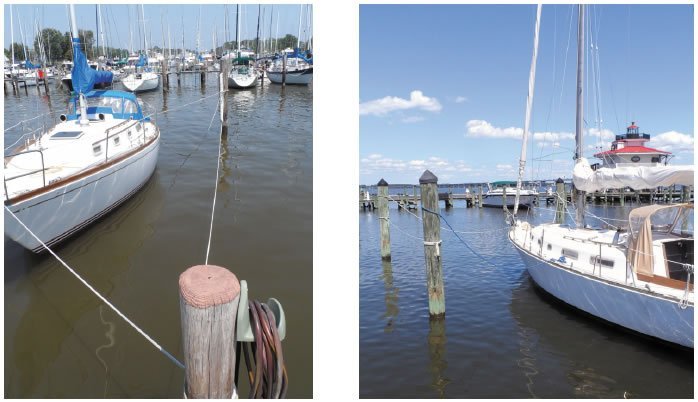Practical Sailor has covered storm preparation on several occasions. The two most extensive articles appeared in July 2008 Gear for Battening Down Ahead of Storms, and Tropical Storms Dos and Dont’s, from November 2011. We also have an online article How to Help Your Boat Survive a Major Storm. We also did a recent report on the importance of spring lines in strong winds, Spring Lines for Storm Preparedness. Don’t wait until a storm is headed your way to read these reports and formulate your own storm safety plan.
Our first choice in a storm is a haulout facility, preferable well-inland and out of the path of the storm. The facility shouldn’t be vulnerable to storm surge, and it should be equipped with fixed anchors to tie your boat down. Second choice would be a hurricane hole with good holding, again well inland and out of the storms path. What follows are just a few tips relevant to securing your boat in a marina when you have exhausted all other safer alternatives. It is very likely that none of these measures will be of little help in a direct hit.

Dock line size varies both with boat size and expected wind speed. Boats docked in hurricane or other severe weather areas should consider going up a size from common recommendations. However, be sure your deck cleats can stand up to the loads (see point below). In some cases, you may be able to reroute lines to stronger anchor points, reinforce the cleat with a secondary line to a backup anchor point (the opposite side cleat, for example), or spread the load to multiple anchor points. In the future, new cleats and backing plates may be in order. Our recent report on backing plates, “Loading Up Backing Plates,” compares various materials for reinforcing cleats and hardware.
Loads on the cleat of a 35- to 40-foot boat during an actual hurricane can exceed one ton. While boatbuilding standards (the American Boat and Yacht Council in the U.S.) specify load-carrying ability, some older dock cleats are not up to snuff. Do you trust the dock cleats and pilings at the anticipated loads? If not, find alternate anchor points. The base of the mast may be a good anchor point for some situations.
If your boat is 30-feet or longer and you do not yet have mid-ships cleats for attaching spring lines, consider adding them at the next opportunity. These should be sized and backed in the same manner as bow cleats, since loads are the same or greater. If you are using some other point on the boat as a substitute for mid-ship cleats, choose hardware that is best aligned to withstand the loads (see above point).
Remember the chafing gear. Preferably something water can permeate for cooling and lubrication. For a round-up of effective chafe gear see Round 2: Chafe Gear for Mooring and Dock Lines, October 2012.
Removing canvas and sails reduces windage. Specifically, remove the furling jib, one of the most common storm casualties. Dodgers and other canvas will also suffer if left up during the storm.
Don’t leave anything on deck. Even dense objects can be blown across the deck and do damage, or be lost overboard.
Use plenty of fenders. Fenders need to protect you from the dock and neighboring boats. A fender board can be particularly useful in some scenarios. Making a fender board is relatively quick and easy, as I described in my recent blog post, “Building a Better Boat Fender.”
Check your neighbors lines. If the boat appears to pose a threat to your own, try to contact the owner, and notify the marina staff. Failing these, deciding whether to take action yourself is a personal decision. What would you want someone to do if the boat was yours?
Floating versus fixed docks. Properly designed floating docks are generally considered a safer option than fixed docks, with some important caveats. The support pilings must be high enough for the predicted storm surge. A six-foot piling is generally considered inadequate in coastal areas. Eighteen feet is the norm in many storm-prone areas.
Using anchors. If you side-tie and you don’t have a tie-off point opposite to your dock, well-set anchors with plenty of scope can help relieve the pressure on your fenders. Unfortunately, many marinas offer very poor holding. Your best bet in soft mud is a large fluke Danforth-style anchor. If the direction of pull is not going to change drastically a tandem anchor rig is worth considering.
Lastly, any marina facing significant storm surge is simply not safe, but those protected from a long fetch by a low wave barrier are particularly vulnerable. Boat owners on the Chesapeake got an expensive lesson in this during Hurricane Isabel. The above advice is aimed only at those boat owners who have no other option but to keep their boat in a marina-a roll of the dice at best.

































Thank you so much this information was certainly helpful. Most folks have to learn this the hard way.